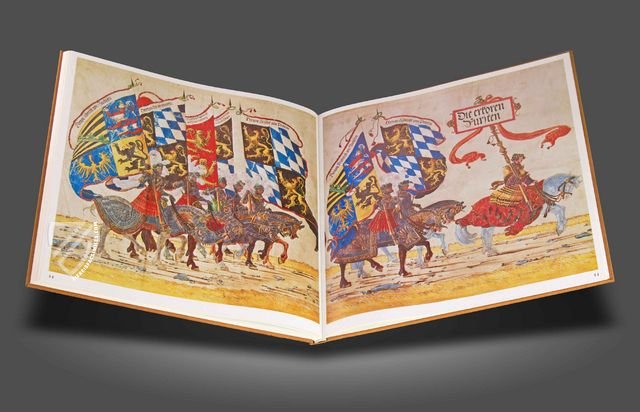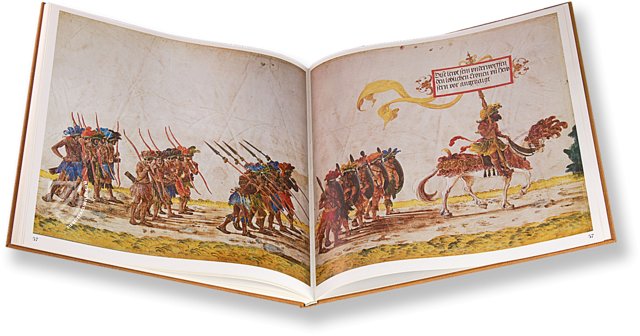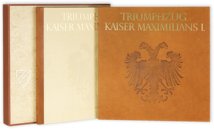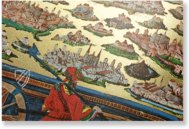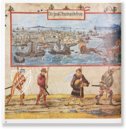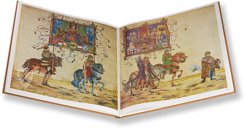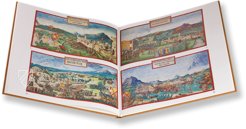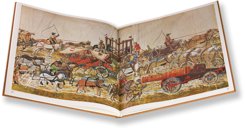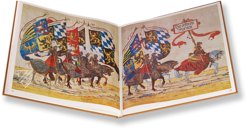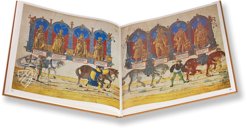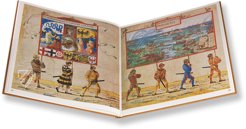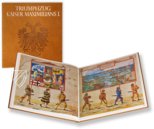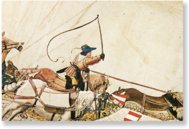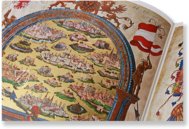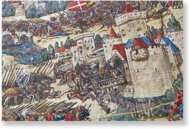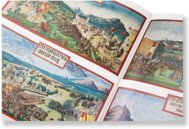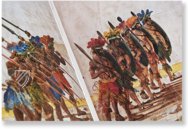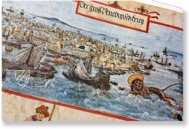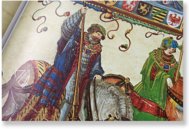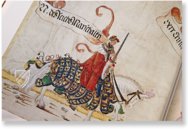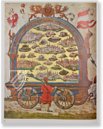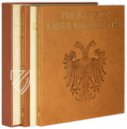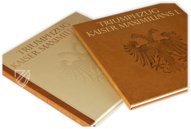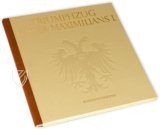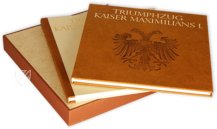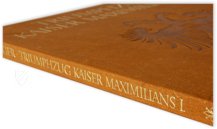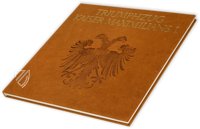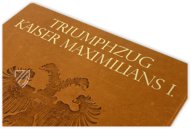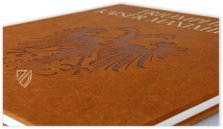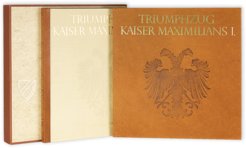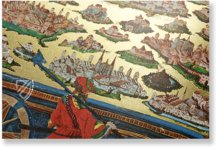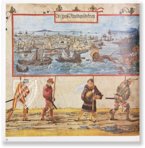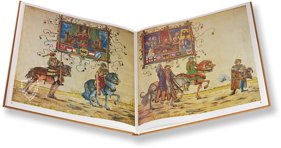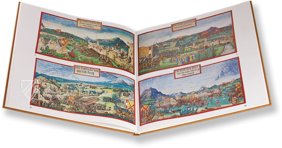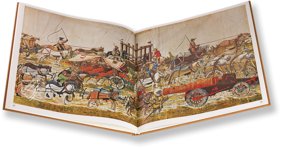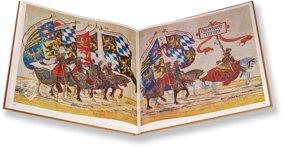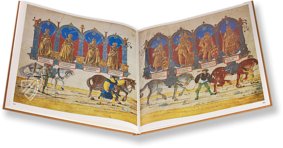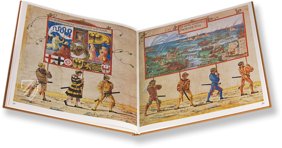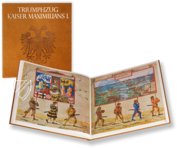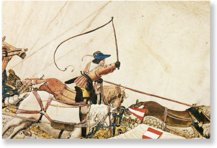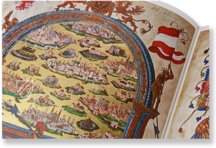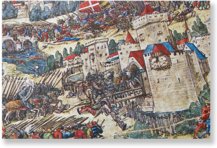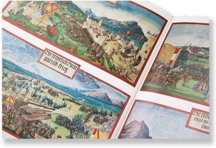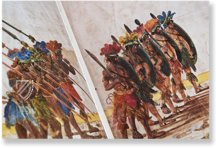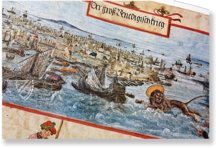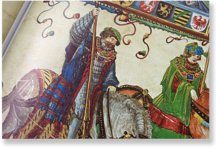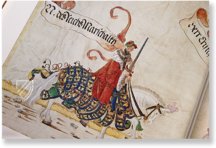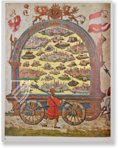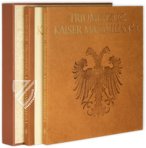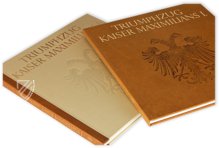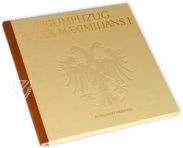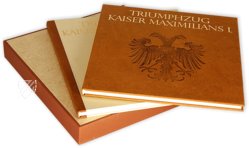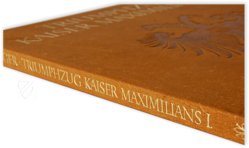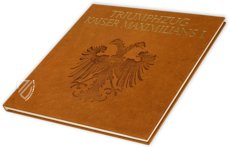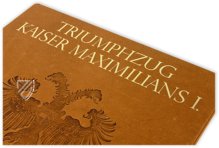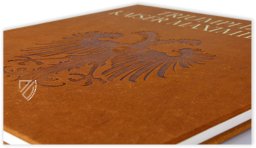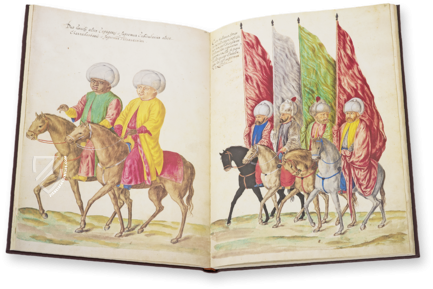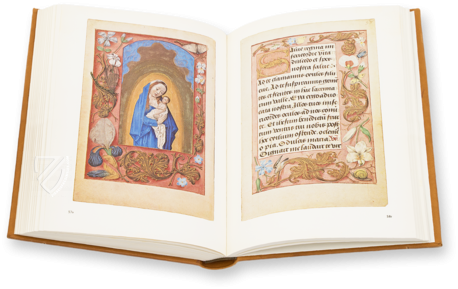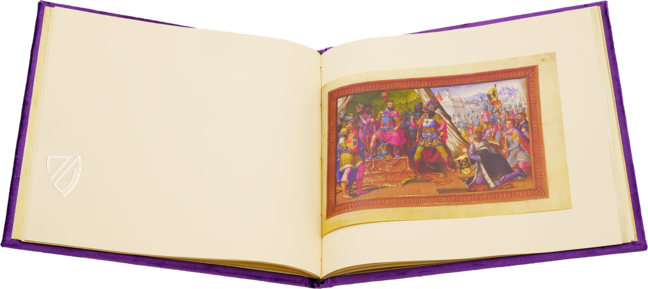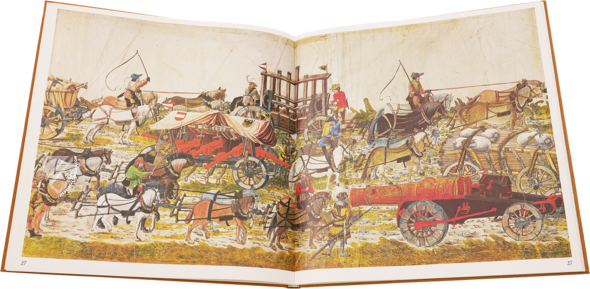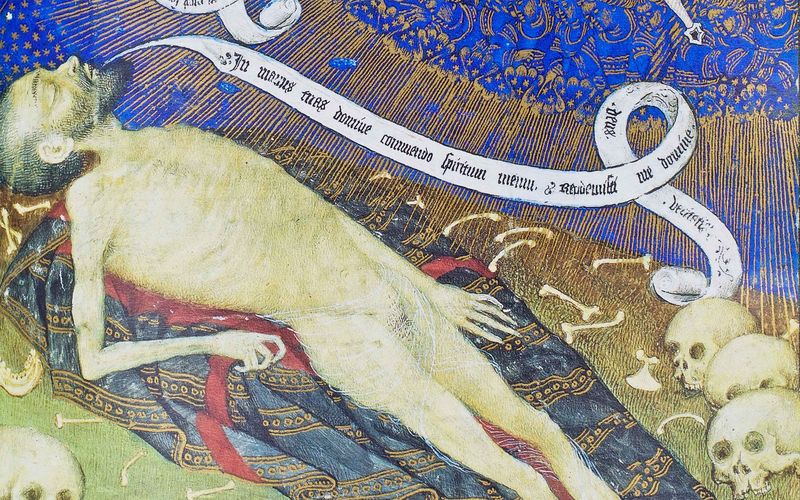Triumphal Procession of Emperor Maximilian I - Graz Codex
(1,000€ - 3,000€)
Although often referred to as “the last knight”, Emperor Maximilian I was one of the first rulers to understand the use of propaganda as a mean of creating an image of himself for both the contemporary public and posterity as well. He also understood the power of the printing press and patronized the most talented engravers. The Triumphal Procession or Triumphs of Maximilian is a monumental series of woodcuts that measures approximately 54 meters in length and was designed by Albrecht Altdorfer, who captured both the solemnity and festivity of the participants in the triumphs.
Hans Burgkmair, Albrecht Altdorfer, Hans Spinginklee, Leonhard Beck, Hans Schäufelein, Wolf Huber, and Albrecht Dürer all contributed engravings to the project. Originally designed for 210 illustrations, 137 were completed at the time of Maximilian’s death in 1519. The Graz Codex consists of 99 woodcuts, which were colored in 1765. They are not reproduced in the correct order and are mounted in pairs on a passe-partout, but this "wrong" order is now part of the historical value of the work.
Triumphal Procession of Emperor Maximilian I – Graz Codex
The most important and extensive of the works commissioned by Emperor Maximilian I (1459–1519) is his Triumphal Procession, which does not depict an actual event but rather an imaginary parade in honor of the Emperor, who conceived of this work himself in 1512. The project was completed in 1515 by the German Renaissance master Albrecht Altdorfer (ca. 1480–1538). This unique and magnificent work is inspired by the festive processions of victorious emperors in Rome and their adaptations in the Italian Renaissance but appears as a contemporary pageant with depictions of the most important people and events from the emperor's life. Furthermore, it is filled with detailed depictions of clothing including the extravagantly dressed landsknechts as well as armor, weapons, canons, horses, wagons, and other equipment from the early 16th century.
An All-Star Team of Artists
The list of names involved in the creation of these woodcuts includes some of the greatest artists of the German Renaissance: the design for 67 of the woodblocks is attributed to Jörg Kölderer, who served as Maximilian’s court painter in Tyrol from 1494 to 1518. 38 blocks were designed by Albrecht Altdorfer, 20 by Hans Springinklee, 7 by Leonhard Beck, 2 from Wolf Huber and even Albrecht Dürer (1471–1528) contributed 2 including his famous Large Triumphal Carriage. These designs were cut between 1516 and 1519 by a large team of block-cutters led by Jost de Negker that included Hieronymus Andreae, Cornelis Liefrinck, and Willem Liefrinck. 139 blocks were complete when Maximilian died, and many portraits of various courtiers and nobles were never made. Nonetheless, the Triumphal Procession stands out as a masterpiece of both art and propaganda that reflects Maximilian’s tremendous intelligence and vision.
The First Edition
This first edition print from 1526 originally consisted of 109 woodcuts, 99 of which are preserved in the Graz University Library, which is attested to by a watermark consisting of a crowned double-headed eagle with a sickle on its breastplate that appears on 43 of the leaves. These prints measuring ca. 41 cm × 37 cm were colored by Josef Höger in 1765 with the assistance of an apprentice who colored the backgrounds. Although the Graz Codex is incomplete and is missing the triumphal chariots, all but two depictions of prisoners of war are preserved. It does include prints of two woodblocks that were lost after the initial printing: one depicts Maximilian’s 1477 marriage to Mary of Burgundy (1457–82) and the other the beginning of the baggage train. The illustrations were put in the incorrect order when the Graz Codex was bound and can be divided into the following sections: heralds and standard bearers introduce the procession, followed by musicians, on foot and on chariots, then soldiers, hunters, and tournament riders. The final part of the procession is – correctly – the baggage train full of military gear and various everyday objects.
History of the Codex
There is evidence of the woodblocks in the inventory of the treasury of Graz Castle during the 16th century, where it is described as: “Item unterschiedlich größere und kleinere Holzstich, so thails zerstäet, thails aber zusamben gebunden” and “Ein große Truchen, warinen allerlei schrüften und auf Papier gedruckhte Holzstich”. A letter dated 1591 from Maria Anna of Bavaria to her brother, Duke Wilhelm V, describes the incredible beauty and uniqueness of the woodcuts. The work was still in the personal possession of the Hapsburgs in 1765 when Empress Maria Theresa divided it up and gave it away to three court officials. Incredibly, they were somehow described as “insignificant pieces” at the time. In the same year, the leaves and accompanying woodblocks were acquired by the Jesuit College in Graz, which stored them for a time in the mathematical tower, an observatory of the old university. It was here that they were colored by Josef Höger. After the college’s dissolution, the leaves and the woodblocks came into the possession of the University Library of Graz and the woodblocks were eventually returned to Vienna in the late-18th century.
Codicology
- Alternative Titles
- Triumphzug Kaiser Maximilians I. - Grazer Codex
- Size / Format
- 198 pages / 41.0 × 37.0 cm
- Origin
- Austria
- Date
- 1526
- Epochs
- Style
- Language
- Illustrations
- 99 colored woodcut prints
- Patron
- Emperor Maximilian I
- Artist / School
- Hans Burgkmair, Hans Leonhard Schäufelein, Albrecht Dürer and Hans Springinklee
Triumphal Procession of Emperor Maximilian I - Graz Codex
Maximilian's Conquests
A lansquenet armed with a halberd admires a collage of conquered cities and castles, which as a panel painting on a carriage is part of the procession. The urban “islands” appear to be swimming in a shimmering sea of gold, but are depicted with astonishing detail and individualization. Although not inscribed, they could certainly be recognized by some contemporary readers. However, many of the medieval “skylines” were already severely reshaped a century later by the Thirty Years' War.
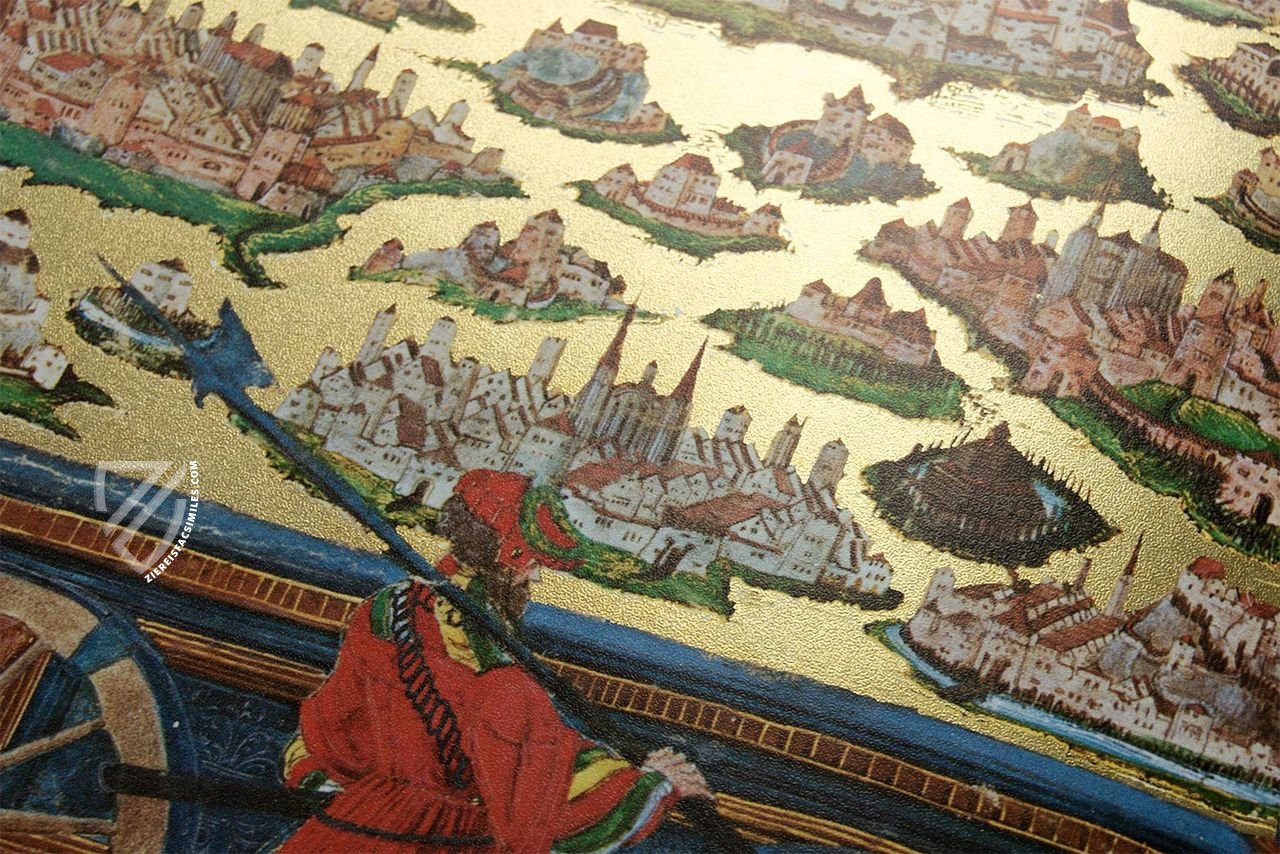
Triumphal Procession of Emperor Maximilian I - Graz Codex
The Great Venetian War
Between 1508 and 1510, the League of Cambrai, an alliance of various European rulers under Pope Julius II, of which Maximilian I was a member, waged a war against Venice in order to curb its expansion in northern Italy. Maximilian's aim was to strengthen his own power political position in the long term, which he succeeded in doing.
Although the alliance was unable to achieve a real victory, Venice no longer posed such a great threat after the war. The alliance also established a friendship between Maximilian, Ferdinand II of Aragon and Henry VII of England, which secured the imperial succession. So it is no wonder that the event was included in the triumphal procession.
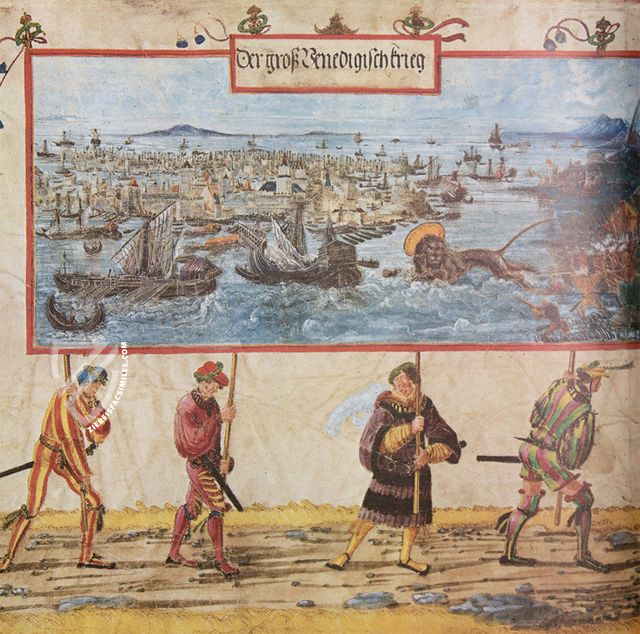
#1 Triumphal Procession of Emperor Maximilian I - Graz Codex
Language: German
(1,000€ - 3,000€)
- Treatises / Secular Books
- Apocalypses / Beatus
- Astronomy / Astrology
- Bestiaries
- Bibles / Gospels
- Chronicles / History / Law
- Geography / Maps
- Saints' Lives
- Islam / Oriental
- Judaism / Hebrew
- Single Leaf Collections
- Leonardo da Vinci
- Literature / Poetry
- Liturgical Manuscripts
- Medicine / Botany / Alchemy
- Music
- Mythology / Prophecies
- Psalters
- Other Religious Books
- Games / Hunting
- Private Devotion Books
- Other Genres
- Afghanistan
- Armenia
- Austria
- Belgium
- Belize
- Bosnia and Herzegovina
- China
- Colombia
- Costa Rica
- Croatia
- Cyprus
- Czech Republic
- Denmark
- Egypt
- El Salvador
- Ethiopia
- France
- Germany
- Greece
- Guatemala
- Honduras
- Hungary
- India
- Iran
- Iraq
- Israel
- Italy
- Japan
- Jordan
- Kazakhstan
- Kyrgyzstan
- Lebanon
- Liechtenstein
- Luxembourg
- Mexico
- Morocco
- Netherlands
- Palestine
- Panama
- Peru
- Poland
- Portugal
- Romania
- Russia
- Serbia
- Spain
- Sri Lanka
- Sweden
- Switzerland
- Syria
- Tajikistan
- Turkey
- Turkmenistan
- Ukraine
- United Kingdom
- United States
- Uzbekistan
- Vatican City
- A. Oosthoek, van Holkema & Warendorf
- Aboca Museum
- Ajuntament de Valencia
- Akademie Verlag
- Akademische Druck- u. Verlagsanstalt (ADEVA)
- Aldo Ausilio Editore - Bottega d’Erasmo
- Alecto Historical Editions
- Alkuin Verlag
- Almqvist & Wiksell
- Amilcare Pizzi
- Andreas & Andreas Verlagsbuchhandlung
- Archa 90
- Archiv Verlag
- Archivi Edizioni
- Arnold Verlag
- ARS
- Ars Magna
- ArtCodex
- AyN Ediciones
- Azimuth Editions
- Badenia Verlag
- Bärenreiter-Verlag
- Belser Verlag
- Belser Verlag / WK Wertkontor
- Benziger Verlag
- Bernardinum Wydawnictwo
- BiblioGemma
- Biblioteca Apostolica Vaticana (Vaticanstadt, Vaticanstadt)
- Bibliotheca Palatina Faksimile Verlag
- Bibliotheca Rara
- Boydell & Brewer
- Bramante Edizioni
- Bredius Genootschap
- Brepols Publishers
- British Library
- C. Weckesser
- Caixa Catalunya
- Canesi
- CAPSA, Ars Scriptoria
- Caratzas Brothers, Publishers
- Carus Verlag
- Casamassima Libri
- Centrum Cartographie Verlag GmbH
- Chavane Verlag
- Christian Brandstätter Verlag
- Circulo Cientifico
- Club Bibliófilo Versol
- Club du Livre
- CM Editores
- Collegium Graphicum
- Collezione Apocrifa Da Vinci
- Comissão Nacional para as Comemorações dos Descobrimentos Portugueses
- Coron Verlag
- Corvina
- CTHS
- D. S. Brewer
- Damon
- De Agostini/UTET
- De Nederlandsche Boekhandel
- De Schutter
- Deuschle & Stemmle
- Deutscher Verlag für Kunstwissenschaft
- DIAMM
- Droz
- E. Schreiber Graphische Kunstanstalten
- Ediciones Boreal
- Ediciones Grial
- Ediclube
- Edições Inapa
- Edilan
- Editalia
- Edition Deuschle
- Edition Georg Popp
- Edition Leipzig
- Edition Libri Illustri
- Editiones Reales Sitios S. L.
- Éditions de l'Oiseau Lyre
- Editions Medicina Rara
- Editorial Casariego
- Editorial Mintzoa
- Editrice Antenore
- Editrice Velar
- Edizioni Edison
- Egeria, S.L.
- Eikon Editores
- Electa
- Emery Walker Limited
- Enciclopèdia Catalana
- Eos-Verlag
- Ephesus Publishing
- Ernst Battenberg
- Eugrammia Press
- Extraordinary Editions
- Fackelverlag
- Facsimila Art & Edition
- Facsimile Editions Ltd.
- Facsimilia Art & Edition Ebert KG
- Faksimile Verlag
- Feuermann Verlag
- Folger Shakespeare Library
- Franco Cosimo Panini Editore
- Friedrich Wittig Verlag
- Fundación Hullera Vasco-Leonesa
- G. Braziller
- Gabriele Mazzotta Editore
- Gebr. Mann Verlag
- Gesellschaft für graphische Industrie
- Getty Research Institute
- Giovanni Domenico de Rossi
- Giunti Editore
- Graffiti
- Grafica European Center of Fine Arts
- Guido Pressler
- Guillermo Blazquez
- Gustav Kiepenheuer
- H. N. Abrams
- Harrassowitz
- Harvard University Press
- Helikon
- Hendrickson Publishers
- Henning Oppermann
- Herder Verlag
- Hes & De Graaf Publishers
- Hoepli
- Holbein-Verlag
- Houghton Library
- Hugo Schmidt Verlag
- Idion Verlag
- Il Bulino, edizioni d'arte
- ILte
- Imago
- Insel Verlag
- Insel-Verlag Anton Kippenberger
- Instituto de Estudios Altoaragoneses
- Instituto Nacional de Antropología e Historia
- Istituto dell'Enciclopedia Italiana - Treccani
- Istituto Ellenico di Studi Bizantini e Postbizantini
- Istituto Geografico De Agostini
- Istituto Poligrafico e Zecca dello Stato
- Italarte Art Establishments
- Jan Thorbecke Verlag
- Johnson Reprint Corporation
- Josef Stocker
- Josef Stocker-Schmid
- Jugoslavija
- Karl W. Hiersemann
- Kasper Straube
- Kaydeda Ediciones
- Kindler Verlag / Coron Verlag
- Kodansha International Ltd.
- Konrad Kölbl Verlag
- Kurt Wolff Verlag
- La Liberia dello Stato
- La Linea Editrice
- La Meta Editore
- Lambert Schneider
- Landeskreditbank Baden-Württemberg
- Leo S. Olschki
- Les Incunables
- Liber Artis
- Library of Congress
- Libreria Musicale Italiana
- Lichtdruck
- Lito Immagine Editore
- Lumen Artis
- Lund Humphries
- M. Moleiro Editor
- Maison des Sciences de l'homme et de la société de Poitiers
- Manuscriptum
- Martinus Nijhoff
- Maruzen-Yushodo Co. Ltd.
- MASA
- Massada Publishers
- McGraw-Hill
- Metropolitan Museum of Art
- Militos
- Millennium Liber
- Müller & Schindler
- Nahar - Stavit
- Nahar and Steimatzky
- National Library of Wales
- Neri Pozza
- Nova Charta
- Oceanum Verlag
- Odeon
- Orbis Mediaevalis
- Orbis Pictus
- Österreichische Staatsdruckerei
- Oxford University Press
- Pageant Books
- Parzellers Buchverlag
- Patrimonio Ediciones
- Pattloch Verlag
- PIAF
- Pieper Verlag
- Plon-Nourrit et cie
- Poligrafiche Bolis
- Presses Universitaires de Strasbourg
- Prestel Verlag
- Princeton University Press
- Prisma Verlag
- Priuli & Verlucca, editori
- Pro Sport Verlag
- Propyläen Verlag
- Pytheas Books
- Quaternio Verlag Luzern
- Reales Sitios
- Recht-Verlag
- Reichert Verlag
- Reichsdruckerei
- Reprint Verlag
- Riehn & Reusch
- Roberto Vattori Editore
- Rosenkilde and Bagger
- Roxburghe Club
- Salerno Editrice
- Saltellus Press
- Sandoz
- Sarajevo Svjetlost
- Schöck ArtPrint Kft.
- Schulsinger Brothers
- Scolar Press
- Scrinium
- Scripta Maneant
- Scriptorium
- Shazar
- Siloé, arte y bibliofilia
- SISMEL - Edizioni del Galluzzo
- Sociedad Mexicana de Antropología
- Société des Bibliophiles & Iconophiles de Belgique
- Soncin Publishing
- Sorli Ediciones
- Stainer and Bell
- Studer
- Styria Verlag
- Sumptibus Pragopress
- Szegedi Tudomànyegyetem
- Taberna Libraria
- Tarshish Books
- Taschen
- Tempus Libri
- Testimonio Compañía Editorial
- Thames and Hudson
- The Clear Vue Publishing Partnership Limited
- The Facsimile Codex
- The Folio Society
- The Marquess of Normanby
- The Richard III and Yorkist History Trust
- Tip.Le.Co
- TouchArt
- TREC Publishing House
- TRI Publishing Co.
- Trident Editore
- Tuliba Collection
- Typis Regiae Officinae Polygraphicae
- Union Verlag Berlin
- Universidad de Granada
- University of California Press
- University of Chicago Press
- Urs Graf
- Vallecchi
- Van Wijnen
- VCH, Acta Humaniora
- VDI Verlag
- VEB Deutscher Verlag für Musik
- Verlag Anton Pustet / Andreas Verlag
- Verlag Bibliophile Drucke Josef Stocker
- Verlag der Münchner Drucke
- Verlag für Regionalgeschichte
- Verlag Styria
- Vicent Garcia Editores
- W. Turnowski Ltd.
- W. Turnowsky
- Waanders Printers
- Wiener Mechitharisten-Congregation (Wien, Österreich)
- Wissenschaftliche Buchgesellschaft
- Wissenschaftliche Verlagsgesellschaft
- Wydawnictwo Dolnoslaskie
- Xuntanza Editorial
- Zakład Narodowy
- Zollikofer AG

